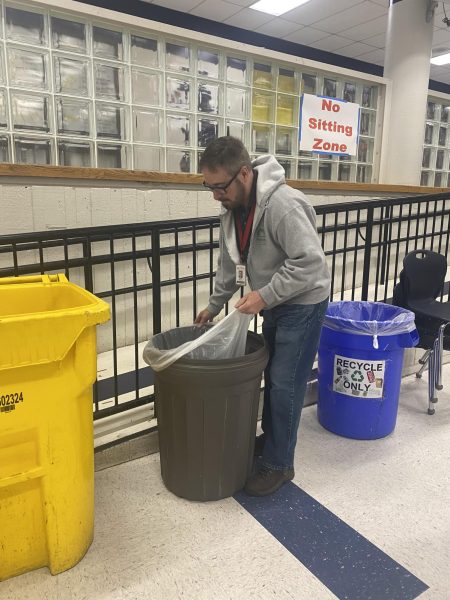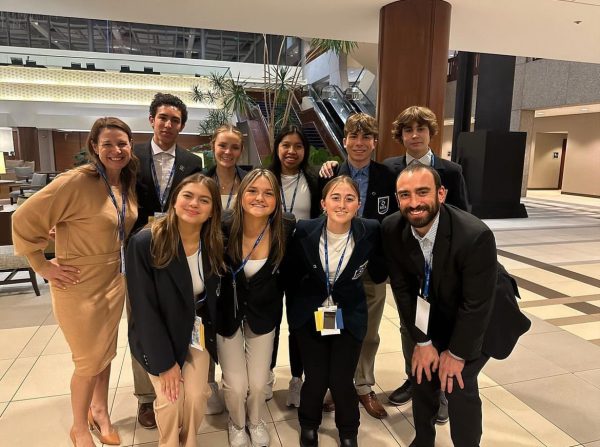Honey bee population on decline
The life of the honey bee isn’t sweet anymore. Honey and almond prices are on the rise because the population of the honeybee, the world’s biggest pollinator, is on the decline. In North America almost a third of the food we consume is from plants pollinated by bees.
Bee populations have been dropping since 1950, when dichlorodiphenyltrichloroethane (DDT) was first widely used. Populations dropped significantly again, in the 1980’s, when parasitic mites were introduced into the states. Then, in the spring of 2007, a term called Colony Collapse Disorder (CCD) came about when many keepers noticed a loss of 30 to 80 percent of their colonies–the entirety of the bees living in one hive. The regular winter die off rates are 10 percent of the colonies. CCD is thought to be caused by a lethal cocktail of pesticide, parasitic mites, and viruses.
Neonicotinoids (neonics) are a type of pesticide found on most fruit, vegetable, and ornamental plants. Imidacloprid, a neonic, causes the bees to become disoriented, preventing them from returning to the hive and can weaken immune systems. According to Bayer CropScience LP, the neonicotinoids are safer, when used with regulation. Unfortunately they are not always used with regulation.
Across the Atlantic, the European Union has prohibited these chemicals. They seem to be using a ‘guilty until proven innocent’ approach rather than the U.S’s ‘innocent until proven guilty’ ideology.
According to the Environmental Protection Agency, “Our role in the federal response to CCD is to keep abreast of and help advance research investigating pesticide effects on pollinators. While our longstanding regulatory requirements for pesticides are designed to protect beneficial insects such as bees, since 2007 we have been looking at many different ways of possibly improving pollinator protection.” A recent study published by the Environmental Protection Agency stated that these neonics provide the same results as other pesticides but prove more harmful to bees. Despite this, companies like Home Depot and Lowes still sell plants that have been sprayed with the chemicals.
The honeybee is not the only animals being affected by these dangerous products. Neonics like Imidacloprid and Sulfoxaflor can work into the roots and vascular systems of plants. This will affect the immune systems of hummingbirds, butterflies, and countless other pollinating insects along with plant eating ones. And, if sprayed in enough concentration, neonicotinoids can affect animals like rabbits and squirrels.
Adding to bee keeper stress are little pests called mites (Varroa destructor). According to local beekeeper Tim Graham, “Mites are always an issue,” he said. “If you check for mites and find over five percent you have a problem.” His mite levels currently sit around three percent.
The mites can quickly outnumber the bees as well. One bee larva fits into one of the cells (think honeycomb). Three mite larva can fit into one cell. Once in the cell the mites will suck the blood from the lava as it matures. The mites will also suck the blood from adult bees. This blood sucking puts a lot of stress on the bees and weakens immune systems.
Counting and countering these mites is what Graham is doing a fair amount of the time he spends with his bees.
Using a thyme based remedy Graham can kill the mites. Unfortunately it causes the honey to be inedible and after a few years he will have to replace the hive boxes,
“You gotta do what you got to do,” Graham said.
The viruses are caused simply by the mite weakening the bees immune systems but can also get picked up off the flowers and plants the bees pollinate. These viruses won’t necessarily affect the honey quality but it can affect how much honey is produced.
A seasonal decline in bee population will come this winter. Hives can reach sixty thousand bees but keepers may lose up to fifty thousand bees in one winter. In the winter most of the drones (male bees) will be ejected from the hive to die. However, the drones to not account for the large drop in numbers because they number no more than one thousand of sixty thousand total bees. The bees will self-regulate and actually stop the bees that collect pollen and nectar from entering the hive once temperatures begin dropping. At the same time the egg production will slow down.
The winter is when Colony Collapse Disorder occurs. The remaining ten thousand bees just fly away and die. What’s confusing keepers is why the bees feel the urge to leave even though they might, and most likely will, die.
During the cold season they need to stay in the hive in order to survive. The bees will get into a big group, much like penguins, and huddle up together around their queen to try to keep her above ninety degrees. The keeper so much as opening his hives may end up killing a few hundred bees.
Some, bigger scale, keepers will ship their bees off to California in the winter so they can pollinate the almond crop. This six billion dollar business may see some decline this winter due to the lack of rain throughout the state.
For keeper Tim Graham, late summer is about focusing on keeping down the mite population. “`Right now, I’m focusing on trying to bring the mite population down as much as I can. I know zero is impossible but even dropping a percent is going to be difficult,” said Graham.
Here at south some students are okay with the drop in bee populations, “Bees are bees. If they’re being annoying I’ll try and kill it,” said junior Alec Gardner.
Killing every bee that annoys you won’t cause as much of a drop in population as the constant use of neonicotinoids. You can help prevent this by purchasing plants for smaller, privately owned nurseries.










